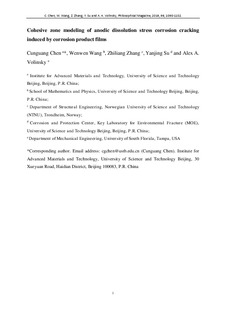| dc.contributor.author | Chen, Cunguang | |
| dc.contributor.author | Wang, Wenwen | |
| dc.contributor.author | Zhang, Zhiliang | |
| dc.contributor.author | Su, Yanjing | |
| dc.contributor.author | Volinsky, Alex A. | |
| dc.date.accessioned | 2019-07-05T07:04:28Z | |
| dc.date.available | 2019-07-05T07:04:28Z | |
| dc.date.created | 2019-02-12T10:26:09Z | |
| dc.date.issued | 2019 | |
| dc.identifier.issn | 1478-6435 | |
| dc.identifier.uri | http://hdl.handle.net/11250/2603494 | |
| dc.description.abstract | Damage mechanics based on the cohesive zone model were applied to study the anodic dissolution stress corrosion cracking (SCC) in flat and U-shaped edge-notched specimens. The simulation results show that corrosion product films (CPFs) facilitate crack initiation in SCC due to the CPF-induced stress and CPF rupture. In the flat specimen, SCC susceptibility increases with the CPF thickness and CPF Young’s modulus, while it decreases with CPF fracture strength. For the U-shaped edge-notched specimen, the normalised threshold stress intensity factor KISCC/KIC decreases with the CPF thickness and notch depth. | nb_NO |
| dc.language.iso | eng | nb_NO |
| dc.publisher | Taylor & Francis | nb_NO |
| dc.title | Cohesive zone modelling of anodic dissolution stress corrosion cracking induced by corrosion product films | nb_NO |
| dc.type | Journal article | nb_NO |
| dc.type | Peer reviewed | nb_NO |
| dc.description.version | acceptedVersion | nb_NO |
| dc.source.journal | Philosophical Magazine | nb_NO |
| dc.identifier.doi | 10.1080/14786435.2019.1575530 | |
| dc.identifier.cristin | 1676259 | |
| dc.description.localcode | Locked until 6.2.2020 due to copyright restrictions. This is an [Accepted Manuscript] of an article published by Taylor & Francis in [Philosophical Magazine] on [06 Feb 2019], available at https://doi.org/10.1080/14786435.2019.1575530 | nb_NO |
| cristin.unitcode | 194,64,45,0 | |
| cristin.unitname | Institutt for konstruksjonsteknikk | |
| cristin.ispublished | true | |
| cristin.fulltext | postprint | |
| cristin.qualitycode | 1 | |
